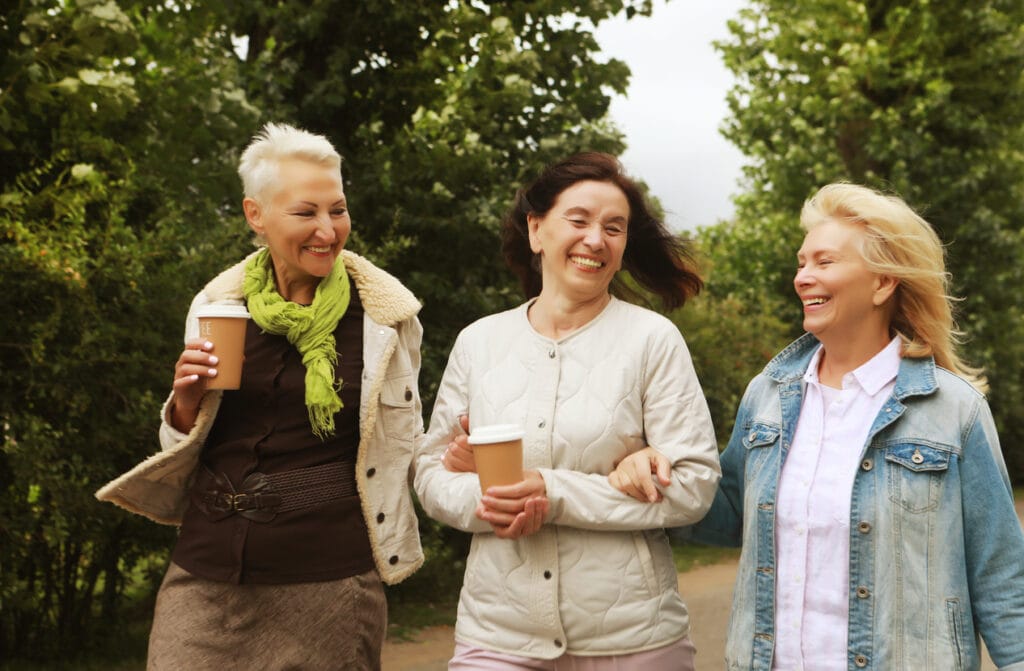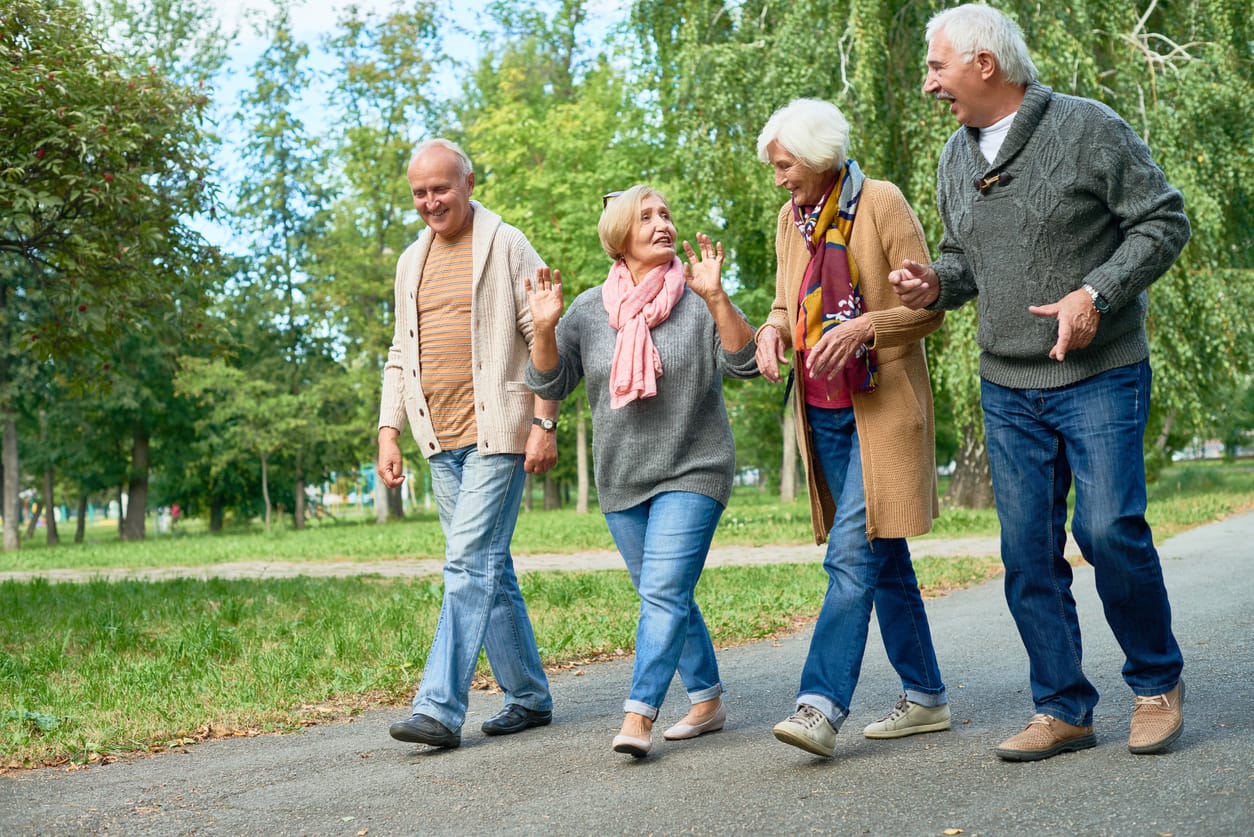The "Best Friends Walk" is an ideal activity for enhancing the lives of our elderly loved ones. Designed specifically for seniors, it promotes physical health, mental wellness, and social interaction. Walking improves heart health, reduces chronic illness risks, and boosts overall fitness. It also enhances mood, alleviating anxiety and depression through fresh air and gentle exercise. Socially, it combats loneliness by fostering meaningful conversations and strengthened bonds. This holistic approach leads to happier, healthier, and more fulfilling lives for our elderly loved ones.
Benefits of Walking for Seniors
Finding activities that enhance the lives of our senior loved ones is always a priority. One simple yet powerful activity is walking. Walking is easy to incorporate into daily routines and offers a wide range of benefits that significantly improve the quality of life for seniors.
- Physical Health Benefits: Walking significantly improves heart health by enhancing cardiovascular fitness and reducing the risk of heart disease. It also enhances balance and stability, which is crucial in preventing falls and ensuring safety. Additionally, walking increases overall mobility, making daily activities easier and more manageable for seniors.
- Mental Health Benefits: Engaging in regular walks helps reduce symptoms of depression and anxiety, which are common among the elderly. The gentle exercise and time spent outdoors can boost mood, provide a sense of accomplishment, and create a positive outlook on life, contributing to better mental health.
- Social Benefits: Walking with friends fosters strong social connections, which is essential in reducing feelings of loneliness and isolation. These walks provide opportunities for meaningful conversations, shared experiences, and the strengthening of bonds with peers, enhancing the social well-being of our elderly loved ones.
Planning the Walk
When planning a walk for our elderly loved ones, it's important to consider several key factors to ensure the experience is enjoyable and safe.
- Choosing the Right Location: Selecting an appropriate location is crucial. Look for places with flat, well-paved paths that are easy to navigate. Community parks or walking trails with ample shade and resting areas are ideal. Additionally, consider the proximity of the location to all participants to make sure it's easily accessible.
- Setting a Date and Time: Timing is essential for comfort and safety. Plan the walk for early morning or late afternoon to avoid peak sun hours, especially in warmer climates. Choose days that are convenient for everyone, possibly avoiding weekends if the chosen location is typically crowded.
- Preparing for Safety and Comfort: Advise participants on what to wear, such as comfortable shoes and light, layered clothing appropriate for the weather. Remind them to bring essentials like water bottles, sunscreen, hats, and any necessary medications. It's also important to have a mobile phone on hand for emergencies.
- Accessibility Considerations: Ensure the route is senior-friendly and accommodates different fitness levels. Check for the availability of public restrooms and their accessibility. If needed, choose a path that allows the use of mobility aids like walkers or wheelchairs.
By carefully planning these aspects, we can create a safe, comfortable, and enjoyable walking experience for our elderly loved ones, promoting their physical, mental, and social well-being.
“Walking is the best possible exercise. Habituate yourself to walk very far.”
Making the Walk Enjoyable
We aim to make every activity enjoyable and engaging for our elderly loved ones. Here are some ways to enhance their walking experience:
Themes and Activities

Introducing themes can make the walk more exciting. Consider organizing a nature walk where participants can appreciate the local flora and fauna, or a historical walk that explores significant landmarks and stories. A photo scavenger hunt can also be a fun and interactive way to keep everyone engaged. Additionally, incorporating light exercises or stretches at the beginning or end of the walk can help prepare and relax the body, making the walk more enjoyable.
Refreshments and Social Time
To add a social element, plan for a post-walk gathering at a nearby café or picnic area. This allows seniors to relax, hydrate, and enjoy each other's company. Encourage participants to bring healthy snacks or arrange a small potluck, fostering a sense of community and shared enjoyment.
By incorporating these elements, we can create a fun, engaging, and memorable walking experience for our elderly loved ones, enriching their physical and social well-being.
Inviting Participants and Spreading the Word
Inviting friends and family to join the walk can enhance the experience for our elderly loved ones. Here are some tips to help spread the word and manage the event effectively:
- Inviting Friends: Reach out to potential participants through various channels. Phone calls are personal and effective, while emails can provide detailed information about the event. Social media is another great tool, allowing you to create event pages and share updates easily. Personal invitations can make everyone feel valued and encourage greater participation.
- Creating a Sign-Up Sheet: To manage the event smoothly, consider creating a sign-up sheet. This can be a simple online form or a physical sheet passed around during social gatherings. A sign-up sheet helps keep track of who is attending, making it easier to plan for the number of participants and ensure everyone receives necessary information.
By inviting friends through multiple channels and organizing participation with a sign-up sheet, we can create a well-coordinated and enjoyable walking event for our elderly loved ones, enhancing their social connections and overall experience.
Follow-Up After the Walk
After the walk, it's important to maintain the momentum and continue providing enriching experiences for our elderly loved ones. Encourage participants to make the "Best Friends Walk" a regular event, giving everyone something to look forward to and allowing them to prepare for upcoming walks. Setting a consistent schedule, such as weekly or bi-weekly, can help build a routine and foster anticipation and excitement. Additionally, gathering feedback from participants through informal conversations, surveys, or feedback forms is crucial for improving future walks. By making the "Best Friends Walk" a recurring event and actively seeking feedback, we can keep participants engaged and continually enhance the experience, promoting the physical, mental, and social well-being of our elderly loved ones.
In conclusion, organizing a "Best Friends Walk" for our elderly loved ones offers numerous benefits, from promoting physical health and enhancing mental well-being to fostering strong social connections. By planning thoughtful and accessible walks, we can create a cherished routine that brings joy and improves the quality of life for our loved ones. We encourage you to take the initiative to plan your own walk, as it’s a wonderful way to stay active and strengthen friendships. Share your experiences or photos from your walks with us, and let us know any tips you have for making these events special. Together, we can enrich the lives of our elderly loved ones through these enjoyable and healthful walks.





